15 Common Wild Plants You Never Thought Were Edible
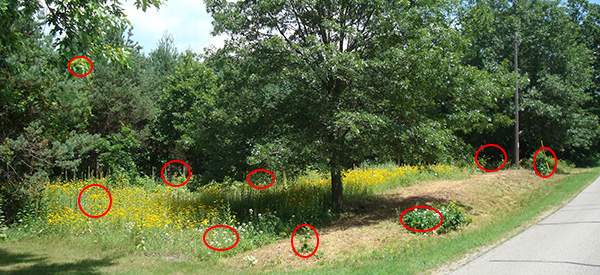
If ever in a situation where you are lost or stranded in the woods or when SHTF, then you will be looking for alternative food sources. There are several things around you that you can eat, but you may have never considered. Wild plants are one such example. These can provide you with the needed nutrients and such, to keep you and your family from starving.
When foraging for these wild edibles it is important to remember that some of these plants will require some basic work before consuming, such as stripping down roots to get to the starchy substance in the middle, or even some grinding of some plant parts before consumption.
That’s why I trust this guide. It’s not an ordinary survival book—it’s a practical resource that teaches the age-old wisdom of living off the land. So, when you find yourself in the wild, make sure this handbook is in your backpack. It could be your key to staying safe when everything else goes wrong.
#1. Ramps
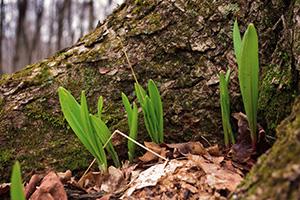
Ramps can be foraged for in the spring. They are kind of a mix between onion and garlic in flavor. The roots grow just below the soil and they grow in patches together.
When digging ramps, it is ideal to conserve the patch by cutting off the root ball with a sharp knife and taking the plant only; this is so you can come back to the same patch next spring. Every part of the ramp is edible and can be eaten raw or used in recipes.
#2. Clover
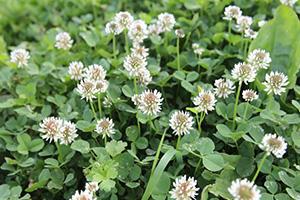 There are different types of clover that grow in your yard, such as red clover and white clover. This is distinctive based on the color of the flower. Simple really. And not just livestock or wild rabbits can eat clover. The whole plant is edible and is best eaten while fresh or completely dried out.
There are different types of clover that grow in your yard, such as red clover and white clover. This is distinctive based on the color of the flower. Simple really. And not just livestock or wild rabbits can eat clover. The whole plant is edible and is best eaten while fresh or completely dried out.
Clover is very healthy for you as it helps ward off colds, reduce respiratory problems, and it is even said that it can purify blood and help ward off cancer. You can grind the leaves to make flour, but it’s a long process. The flower is the best part to eat. When preserving, you can dry the plant and flower head separately. Use a dehydrator, screen in a drying room, or very low temperatures in the oven. Once the plant is dried, you can store it in jars for use over the winter too.
#3. Purslane
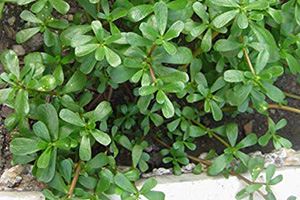 Purslane is identified by the smooth reddish stems and leaves, that are opposite of each other. The flower is yellow with five regular parts and it opens any time of the year at the center of the leaf cluster. Purslane is a ground cover and has a deep root system. The stem, leaves, and flower buds are edible. You can eat it raw in a salad, use in a stir fry, or cooked in soups and other recipes. Purslane has a slightly sour taste. Raw purslane is 93% water.
Purslane is identified by the smooth reddish stems and leaves, that are opposite of each other. The flower is yellow with five regular parts and it opens any time of the year at the center of the leaf cluster. Purslane is a ground cover and has a deep root system. The stem, leaves, and flower buds are edible. You can eat it raw in a salad, use in a stir fry, or cooked in soups and other recipes. Purslane has a slightly sour taste. Raw purslane is 93% water.
#4. Daisies
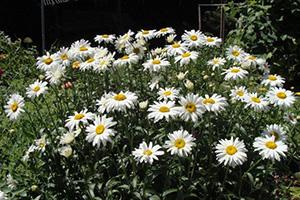 The daisy is a childhood favorite of mine. I used to pick it for my mom and grandmas. I didn’t know you could eat them back then. The flower petals can be used as a garnish or in salads, and the leaves can be used on sandwiches or in salads. It is not recommended that you eat the yellow center of the daisy, as this is the pollen section of the flower.
The daisy is a childhood favorite of mine. I used to pick it for my mom and grandmas. I didn’t know you could eat them back then. The flower petals can be used as a garnish or in salads, and the leaves can be used on sandwiches or in salads. It is not recommended that you eat the yellow center of the daisy, as this is the pollen section of the flower.
#5. Cattails
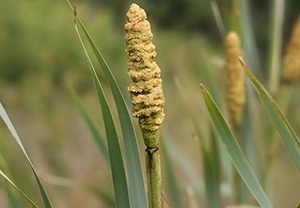 If you have seen a body of water you have probably seen a cattail. The lower leaves can be used in salads, while the stem can be eaten raw or boiled. The cattail itself (the brown cigar shape at the top) can be roasted.
If you have seen a body of water you have probably seen a cattail. The lower leaves can be used in salads, while the stem can be eaten raw or boiled. The cattail itself (the brown cigar shape at the top) can be roasted.
The yellow pollen that appears in midsummer can used as a thickener, and in bread and pancake mixes. The roots contain a lot of starches and can be dried and then pounded into flour, or you can strip it off and chew on it to get the starches and then spit out the tough part. Here are 10 delicious recipes you can make using cattails.
#6. Lamb’s Quarters
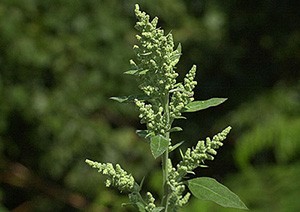 This wild edible looks dusty from a distance due to the white coating on the leaves. The plant produces little green flowers that are grouped together in clusters on the stem and upper branches. When eating lamb’s quarter, you can consume the leaves, shoots, seeds, and flowers. This plant does contain oxalic acid, but when cooked the acid goes away. You can blanch and freeze the leaves for later use. Lamb’s quarter is also good for salads and soups. It can also be sautéed or steamed, as well as a valuable addition to smoothies and juices.
This wild edible looks dusty from a distance due to the white coating on the leaves. The plant produces little green flowers that are grouped together in clusters on the stem and upper branches. When eating lamb’s quarter, you can consume the leaves, shoots, seeds, and flowers. This plant does contain oxalic acid, but when cooked the acid goes away. You can blanch and freeze the leaves for later use. Lamb’s quarter is also good for salads and soups. It can also be sautéed or steamed, as well as a valuable addition to smoothies and juices.
#7. Milk Thistle
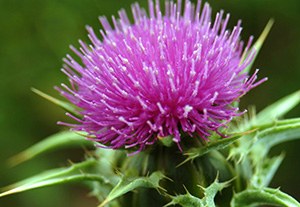 Milk Thistle is good for medicinal purposes but also for eating. You can eat the leaves and flowers as vegetables in a salad. The seeds can also be roasted and used as a coffee substitute, or dried to eat as a snack. The plant has large bright purple flowers, and the leaves have white markings. When broken, a milky sap comes out.
Milk Thistle is good for medicinal purposes but also for eating. You can eat the leaves and flowers as vegetables in a salad. The seeds can also be roasted and used as a coffee substitute, or dried to eat as a snack. The plant has large bright purple flowers, and the leaves have white markings. When broken, a milky sap comes out.
#8. Wild Asparagus
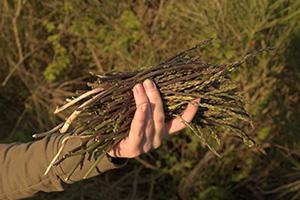 Wild asparagus is edible. It is basically a plant that got transplanted from a seed head which traveled, and from there it started growing in the wild. You will find it along roads and in fields.
Wild asparagus is edible. It is basically a plant that got transplanted from a seed head which traveled, and from there it started growing in the wild. You will find it along roads and in fields.
Look for the asparagus in the late spring to harvest it. If it gets too big, it is going to seed again. And you can return the next spring for a new harvest. Prepare the wild asparagus grilled or baked and seasoned. To store any extra wild asparagus, you can blanch it and freeze it, or seal in vacuum bags.
#9. Goldenrod
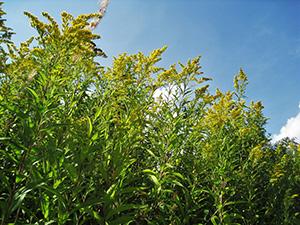 This plant can grow from 24 to 30 inches in height. It is topped with golden flowers that grow in clusters. The leaves taper to a point and have small teeth on the edge. The bottom of the leaf is kind of hairy and rough on the top, with three veins that run parallel along the length of the leaf. Goldenrod can be preserved in about any form, from drying to pickling. Dried flowers and leaves can be added to any meal for a nice flavor. They can also be used for tea. The roots can be harvested when young and dried, and used for soups and batter mixes. Leaves and flowers can be used in salads and soups. The stalk is tough but edible, especially if harvested young. It can be baked in the oven and made into a crispy snack.
This plant can grow from 24 to 30 inches in height. It is topped with golden flowers that grow in clusters. The leaves taper to a point and have small teeth on the edge. The bottom of the leaf is kind of hairy and rough on the top, with three veins that run parallel along the length of the leaf. Goldenrod can be preserved in about any form, from drying to pickling. Dried flowers and leaves can be added to any meal for a nice flavor. They can also be used for tea. The roots can be harvested when young and dried, and used for soups and batter mixes. Leaves and flowers can be used in salads and soups. The stalk is tough but edible, especially if harvested young. It can be baked in the oven and made into a crispy snack.
#10. Chickweed
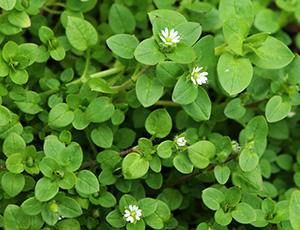 Chickweed is best eaten fresh, but you can also eat it raw. The stem, leaves, flowers, and seed pods can be consumed. You can eat it raw in salads, or you can steam or sauté it. Simply take scissors and cut the amount that you desire.
Chickweed is best eaten fresh, but you can also eat it raw. The stem, leaves, flowers, and seed pods can be consumed. You can eat it raw in salads, or you can steam or sauté it. Simply take scissors and cut the amount that you desire.
Chickweed has little white flowers with five double lobes. The leaves are pointed and oval shaped. They grow in pairs across from each other. The leaves grow far apart on the length of the stem. There is a hairy type line that runs up the stem between the leaves.
#11. Stinging Nettles
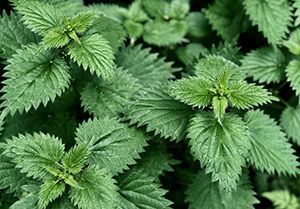 The stinging nettle gets its name by the fact that it has little hairs or spines that irritate your skin, and can even leave welts due to a toxin in them. It is recommended that you only pick the top five to six leaves from the plant, when it is young and before the flowers start to form. To prep the nettles, simply soak them in cold salted water and then drain and dry them. You can freeze them for later use or use them immediately. Stinging nettles can be used as a replacement for spinach, and once cooked they lose their stinging ability.
The stinging nettle gets its name by the fact that it has little hairs or spines that irritate your skin, and can even leave welts due to a toxin in them. It is recommended that you only pick the top five to six leaves from the plant, when it is young and before the flowers start to form. To prep the nettles, simply soak them in cold salted water and then drain and dry them. You can freeze them for later use or use them immediately. Stinging nettles can be used as a replacement for spinach, and once cooked they lose their stinging ability.
#12. Queen Anne’s Lace
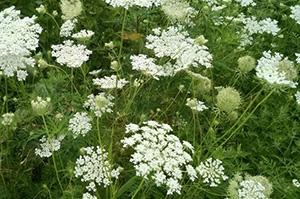 Queen Anne’s lace is also known as wild carrots. This plant has a large flat white flower, with a red or dark center. The stalk is hairy and the root resembles a carrot. It is best to eat the root in the first year, as in the second year it becomes more tough. The green tops are also edible, as you can boil them in soups and stews, or as greenery to dishes. If the stem is not fuzzy or hairy, then it is not Queen Anne’s lace and could be poisonous.
Queen Anne’s lace is also known as wild carrots. This plant has a large flat white flower, with a red or dark center. The stalk is hairy and the root resembles a carrot. It is best to eat the root in the first year, as in the second year it becomes more tough. The green tops are also edible, as you can boil them in soups and stews, or as greenery to dishes. If the stem is not fuzzy or hairy, then it is not Queen Anne’s lace and could be poisonous.
#13. Sorrel
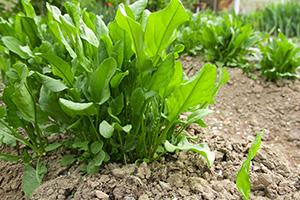 Sorrel is a plant that consists of leafy greens. It has an intense lemony flavor, that becomes more bitter as the leaves age and grow. The smaller leaves can be eaten raw in salads or on sandwiches. The larger leaves should be cooked to help get rid of the bitterness. There are three types of sorrel: red veined, broad leaf, and french. The red veined is self-explanatory, with a slender tapered leaf with red veins throughout it. The broad leaf has slender arrow shaped leaves. The french sorrel has small bell-shaped leaves.
Sorrel is a plant that consists of leafy greens. It has an intense lemony flavor, that becomes more bitter as the leaves age and grow. The smaller leaves can be eaten raw in salads or on sandwiches. The larger leaves should be cooked to help get rid of the bitterness. There are three types of sorrel: red veined, broad leaf, and french. The red veined is self-explanatory, with a slender tapered leaf with red veins throughout it. The broad leaf has slender arrow shaped leaves. The french sorrel has small bell-shaped leaves.
#14. Watercress
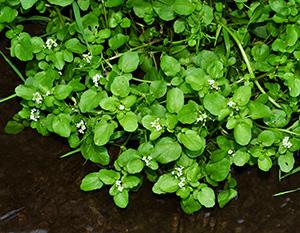 Watercress has a peppery green flavor that goes great with other neutral greens. It can be found all year round in the stores, but it is best in the spring. It is a water grown leafy vegetable, hence the name. If watercress becomes wilted, simply shake it back with cold water, or wrap it in a damp paper towel and place it in a plastic bag.
Watercress has a peppery green flavor that goes great with other neutral greens. It can be found all year round in the stores, but it is best in the spring. It is a water grown leafy vegetable, hence the name. If watercress becomes wilted, simply shake it back with cold water, or wrap it in a damp paper towel and place it in a plastic bag.
You can use watercress by washing it and patting it dry, and then use it raw on sandwiches or in salads, sautéed or steamed.
#15. Berries
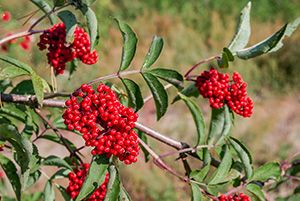 We all have picked blackberries and raspberries, but there are other berries growing in your backyard that are perfectly safe and healthy to eat. Elderberries are ready for harvest in the fall. They grow on shrubs and are a purple to black berry that grows in clusters.
We all have picked blackberries and raspberries, but there are other berries growing in your backyard that are perfectly safe and healthy to eat. Elderberries are ready for harvest in the fall. They grow on shrubs and are a purple to black berry that grows in clusters.
The elderberries must be ripe before consuming, and need to be cooked. This is what kills the astringent poison that they hold. Elderberries are great in syrups, wines, and in cobblers, pies and puddings.
There are many other plants and wild edibles that you can forage for. In the realm of foraging, knowledge is your most potent tool. Our comprehensive guide to wild foods offers an unmatched resource for both beginners and seasoned foragers. We’ve covered everything from.jpeg) the basics of foraging and safety precautions to identifying, harvesting, and preparing wild edibles. So, embark on your foraging journey with confidence, knowing that you have a trusted companion in your pursuit of nature’s hidden treasures. Get your copy of the Foreger’s Guide To Wild Foods HERE
the basics of foraging and safety precautions to identifying, harvesting, and preparing wild edibles. So, embark on your foraging journey with confidence, knowing that you have a trusted companion in your pursuit of nature’s hidden treasures. Get your copy of the Foreger’s Guide To Wild Foods HERE
Anyone can join.
Anyone can contribute.
Anyone can become informed about their world.
"United We Stand" Click Here To Create Your Personal Citizen Journalist Account Today, Be Sure To Invite Your Friends.
Humic & Fulvic Liquid Trace Mineral Complex
HerbAnomic’s Humic and Fulvic Liquid Trace Mineral Complex is a revolutionary New Humic and Fulvic Acid Complex designed to support your body at the cellular level. Our product has been thoroughly tested by an ISO/IEC Certified Lab for toxins and Heavy metals as well as for trace mineral content. We KNOW we have NO lead, arsenic, mercury, aluminum etc. in our Formula. This Humic & Fulvic Liquid Trace Mineral complex has high trace levels of naturally occurring Humic and Fulvic Acids as well as high trace levels of Zinc, Iron, Magnesium, Molybdenum, Potassium and more. There is a wide range of up to 70 trace minerals which occur naturally in our Complex at varying levels. We Choose to list the 8 substances which occur in higher trace levels on our supplement panel. We don’t claim a high number of minerals as other Humic and Fulvic Supplements do and leave you to guess which elements you’ll be getting. Order Your Humic Fulvic for Your Family by Clicking on this Link , or the Banner Below.
Our Formula is an exceptional value compared to other Humic Fulvic Minerals because...
It’s OXYGENATED
It Always Tests at 9.5+ pH
Preservative and Chemical Free
Allergen Free
Comes From a Pure, Unpolluted, Organic Source
Is an Excellent Source for Trace Minerals
Is From Whole, Prehisoric Plant Based Origin Material With Ionic Minerals and Constituents
Highly Conductive/Full of Extra Electrons
Is a Full Spectrum Complex
Our Humic and Fulvic Liquid Trace Mineral Complex has Minerals, Amino Acids, Poly Electrolytes, Phytochemicals, Polyphenols, Bioflavonoids and Trace Vitamins included with the Humic and Fulvic Acid. Our Source material is high in these constituents, where other manufacturers use inferior materials.
Try Our Humic and Fulvic Liquid Trace Mineral Complex today. Order Yours Today by Following This Link.






